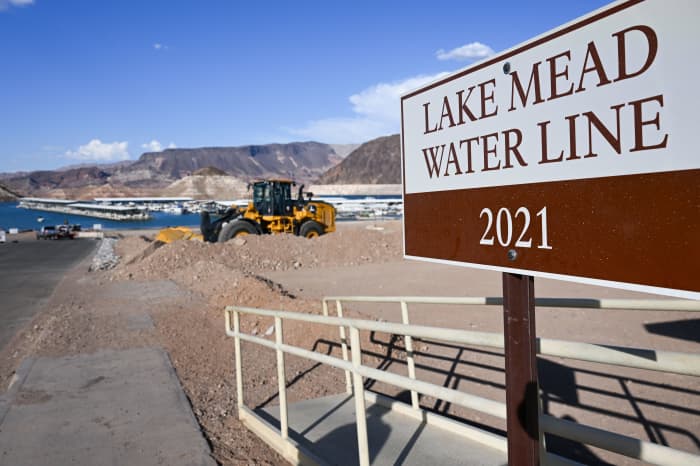Arizona, California and Nevada have advanced a proposed plan to cut their use of water from the drought-ravaged Colorado River for household uses and for hydropower over the next three years.
Negotiations that resulted in the plan, announced Monday, have been hard fought, with the states divided because of major differences in their population sizes and in their use of water for purposes such as agriculture. More than 400 commodities, including over one-third of the U.S.’s vegetables and three-quarters of the country’s fruits and nuts, are grown in California.
But now, federal financial assistance and a lift from a snowy winter and spring rains in replenishing the severely reduced river and its vital Lake Mead reservoir have reinvigorated talks.
According to the new plan, the states aim to conserve a combined additional 3 million acre-feet of water from the 1,450-mile river, which provides water to 40 million people in seven U.S. states, as well as to parts of Mexico and more than two dozen Native American tribes.
One acre-foot is enough water to supply one to two households for a year.
The Colorado River also irrigates some 5.5 million acres of farmland, and the electricity generated by dams on the river’s two main reservoirs, Lake Mead and Lake Powell, powers millions of homes and businesses.
At least half the pledged water savings would have to be conserved as soon as 2024, according to the plan. In exchange for temporarily cutting back on water use, cities, irrigation districts and Native American tribes in Arizona, California and Nevada would receive $1.2 billion in federal funding. Officials have not yet detailed how much of that funding might be allotted to the respective participants.
In April, the U.S. Bureau of Reclamation, part of the Interior Department, released a plan that considered two ways to force cuts in the Colorado River supply for Arizona, Nevada and California, which make up the river’s Lower Basin.
One proposal called for using a decades-old priority system to reduce usage, which would have benefited California and some Native American tribes with senior rights. The other proposal called for a percentage cut across the board so that Arizona and Nevada, the states with lower-priority rights, would not have a greater burden.
The Interior Department on Monday said it would pull back those two proposals and analyze the newly submitted plan. The agreement struck over the weekend runs only through the end of 2026 and still needs to be formally adopted by the federal government.
JB Hamby, chair of the Colorado River Board of California, said in a statement that his state would be responsible for 1.6 million acre-feet in cuts.
No details were immediately provided on how Arizona and Nevada would split the rest of the cuts.
Read: Colorado River shortage should push homeowners everywhere to be smarter about water — here’s how
The Colorado River has been in crisis due to a multidecade drought in the Western U.S. that has been intensified by climate change, rising demand as Americans move west, and overuse. Those pressures have left water levels at key reservoirs along the river at unprecedented lows, although they have rebounded somewhat thanks to above-normal precipitation and deep snowpack this winter and early spring.
In the early months of 2023, mountainous areas of California experienced almost unprecedented snowfall accumulations — more than 40 feet since the start of the season. And at the airport in Flagstaff, Ariz., 11.6 feet of snow fell during the season, second only to the winter of 1948-49.
But these areas and other parts of the U.S. West have been living with a major freshwater deficit for decades. Water levels at Lake Mead — created by Nevada’s Hoover Dam in the 1930s and the largest reservoir among several on the Colorado River — had fallen to record lows, with the lake only one-quarter full in recent years. Levels at the manmade water source have been retreating since 1999 in part due to increased demand from areas with growing populations.
Opinion: This is how Western states must change because of the Colorado River water shortage
In recent years, agreements to cut usage hit Arizona the hardest. In 2022, the state lost some 18% of its share of water from the river, or 512,000 acre-feet of water. That amounted to around 8% of the state’s total water use, the Associated Press reported at the time.
California was spared initially from Lake Mead-related cuts because it has more senior water rights than Arizona and Nevada. But California implemented its own voluntary drought-related water cutbacks in 2021.
The Associated Press contributed to this report.







